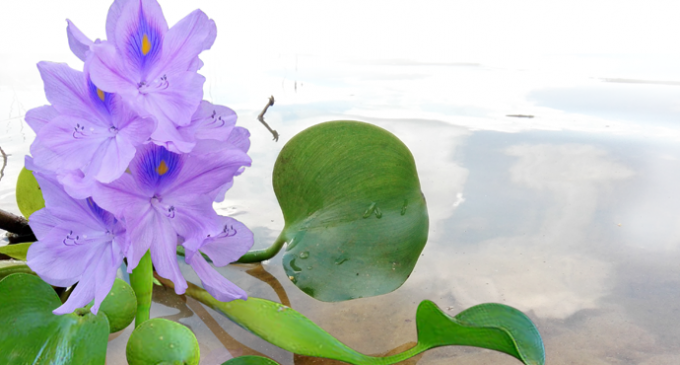WATER HYACINTH OR BEDA

Water Hyacinth botanically named “Eichhomia crassipes” is called ေဗဒါပန္း (Beda flower) in Myanmar. Originally it is an aquatic plant of the Amazon basin, is often considered a highly problematic invasive species outside its native range.
With broad thick glossy ovate leaves this plant can rise above the water surface about one meter. The leaves are thick, 10-12 cm across and can float on the water surface. Long spongy bulbous stalks with feathery freely hanging roots, this plant blooms in profusion, a single spike of 8 to 15 very attractive flowers with lavender to prink hue and six petals in each bloom.
Fast-growing aquatic plant with the capacity of producing thousands of seeds each year, which can remain viable for more than 28 years, this plant has earned the name of a noto-rious pest plant to be controlled timely or to be eradicated for good. They cover entire lake and waterway and destroy all native aquatic plants, blocking water communication. In Myanmar. all inland aquatic bodies across the country are covered with thick carpets of water hyacinth. They provide a very pleasing and refreshing eye feed for the travellers. Green carpets with lavender coloured flowers floating around your watercraft reaching out to the horizon is an aesthetic beauty beyond description.
Though regarded as aquatic pest, water hyacinth can give you a variety of uses for human benefit. They are an excellent source of biomass. They purify water. In some parts of insular South-east Asia they are eaten as green vegetable. In Kedah its flowers are used for medicating horse’s skin.
We now see new and cheap products made of water hyacinths in furniture and lady’s fashion markets: chains, tables, hand bags, and ropes, though not durable like rattan or cane. They are also used for animal food, organic fertilizer, and for paper production on a small scale.]
In Inlay of Southern Shan State of Myanmar, Lake dwellers use carpets of water hyacinths for building their floating islands on which they grow grains and vegetables and also live in their farm cottages.
Myanmar word “Beda” (ေဗဒါ) can be traced as for back to the legends of Tagaung and Pyay Kingdoms. There was a lady named Beda-yee, a niece of a recluse hermit who was sent daily to the shore of the Ayeyarwaddy River to fetch drinking water in a dried gourd bottle with a very small opening for water to come in . She came into contact with two blind princely brothers, floated down on a raft from Tagaung Kingdom. She fell in love with both. The brothers proved to be the nephews of the hermit who was a prince of Tagaung. They set up Pyay dynasty.
In the early British colonial days, there was a famed musician named Sein Beda. He was the leader and master of Myanmar musical ensemble ” Saingwaing.” He won many rewards and awards from Myanmar Last King Thibaw and the British Viceroy of British Indian Empire. Beda is a good name given to both genders in Myanmar Community.
Among outstanding poets of the early 20th century Myanmar Literature, Zawgyi and Minthuwun came out conspicuous. Zawgyi was the pen name of U Thein Han, a native of Pyapone, a town in the Ayeyarwaddy Region. The most famous poem of his was aA’gvrf; (The waterway of water hyacinth). In it he vividly describes the never-ending water journey of water hyacinth, daring and braving dauntlessly all hazards and dangers it meet in the ups and downs of its life.
The poem became a hit movie in post independence period, named “Pan pan hlyat par” (ပန္းပန္လ်က္ပါ) (Still adorning my hair knot with a flower). It was a melodramatic love story of a pretty lady dancer named “Ma Beda” (Miss Hyacinth) played by a many film academy winner film actress Kyi Kyi Htay, co-starred by three film academy winners-actors. Collegian Ney Win, Myat Lay and actress Baby Nwe. After twists and turns of life, the story ended with the hero and heroin “Live happily ever after”.
But the main theme and the philosophy of it are those of Zawgyi’s poem. “The waterway of water hyacinth” (ေဗဒါလမ္း), due to restraint of space in this article, only the chorus stanza is reproduced as follows;
ဘဲအုပ္က တစ္ရာႏွစ္ရာ
မေဗဒါက တစ္ပင္တည္း
အယက္အကန္ခံလို႔
ေဗဒါပ်ံအံကိုခဲ
ပန္းပန္လ်က္ပဲ။
Ducks are one and two hundreds multitude,
But me Ma Beda (Miss Hyacinth) is lonely bloom.
Being kicked and thrown about, but in fortitude,
Dauntlessly bites her determined wisdom teeth, soon.
To face the warmth of her enemies storm
My hair knot is still florally adorned.”
Poet Zawgyi gives you the message of Hyacinth. Life is not plain sailing. The ups and downs of life are its vicissitudes which everyone must go through with heart and soul to reach final destination.
Maha Saddhamma Jotika dhaja
Sithu Dr Khin Maung Nyunt
./wp-content/uploads/2018/10/Emirate-Online-TDY.png)

















There are no comments at the moment, do you want to add one?
Write a comment